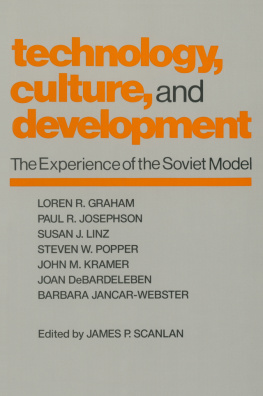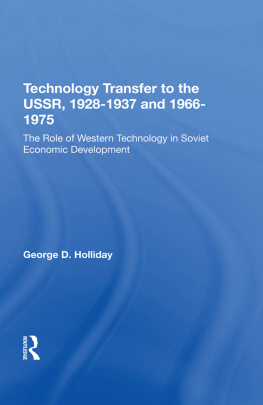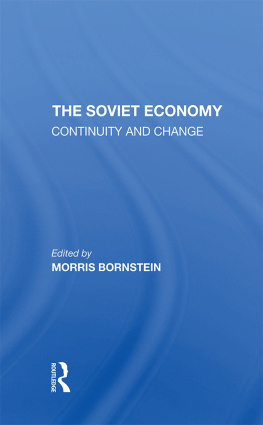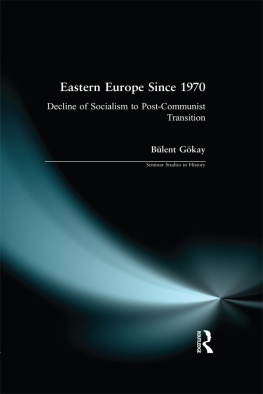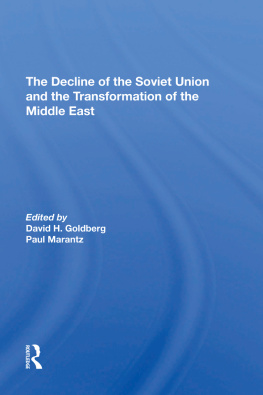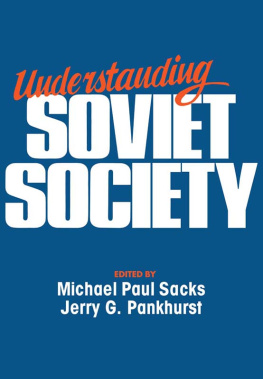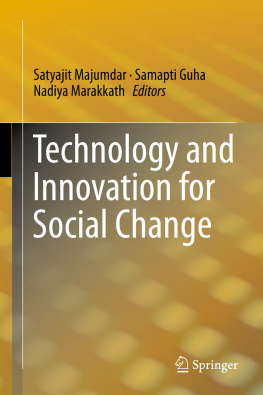technology, culture, and development
The Experience of the Soviet Model
technology, culture, and development
The Experience of the Soviet Model
Loren R. Graham
Paul R. Josephson
Susan J. Linz
Steven W. Popper
John M. Kramer
Joan DeBardeleben
Barbara Jancar-Webster
Edited by James P. Scanlan
First published 1992
by M.E. Sharpe
Published 2015
by Routledge
2 Park Square, Milton Park, Abingdon, Oxon OX14 4RN
711 Third Avenue, New York, NY 10017, USA
Routledge is an imprint of the Taylor & Francis Group, an informa business
Copyright 1992 Taylor & Francis. All rights reserved.
No part of this book may be reprinted or reproduced or utilised in any form or by any electronic, mechanical, or other means, now known or hereafter invented, including photocopying and recording, or in any information storage or retrieval system, without permission in writing from the publishers.
Notices
No responsibility is assumed by the publisher for any injury and/or damage to persons or property as a matter of products liability, negligence or otherwise, or from any use of operation of any methods, products, instructions or ideas contained in the material herein.
Practitioners and researchers must always rely on their own experience and knowledge in evaluating and using any information, methods, compounds, or experiments described herein. In using such information or methods they should be mindful of their own safety and the safety of others, including parties for whom they have a professional responsibility.
Product or corporate names may be trademarks or registered trademarks, and are used only for identification and explanation without intent to infringe.
Library of Congress Cataloging-in-Publication Data
Technology, culture, and development: the experience of the Soviet model /
edited by James P. Scanlan.
p. cm.
Papers presented at a conference held at Ohio State University, Columbus,
on October 27-27, 1990
ISBN 0-87332-891-4.ISBN 0-87332-892-2 (pbk.)
1. Technology and stateSoviet UnionCongresses.
2. TechnologySoviet UnionHistoryCongresses.
I. Scanlan, James P. (James Patrick), 1927-.
T26.S65T43 1992
338.94706-dc20
91-22611
CIP
ISBN 13: 9780873328920 (pbk)
ISBN 13: 9780873328913 (hbk)
Contents
Ecology and Technology in the USSR
Joan DeBardeleben |
The papers in this volume were originally presented at a conference entitled "Technology, Culture, and Development: The Experience of the Soviet Model," held at the Ohio State University, Columbus, Ohio, on October 26 and 27, 1990. The conference, cosponsored by the University Learning Guild and the Center for Slavic and East European Studies at Ohio State, was funded by a grant from the Battelle Endowment for Technology and Human Affairs. The editor and authors wish to express their thanks to the Battelle Endowment for its generous support of this venture.
Although scholars have devoted much attention over the years to the impact of technology on society, they have tended to slight the opposite effectthe impact of social influences (broadly understood) on technology. The authors of the essays in the present volume seek to redress this imbalance: in their examination of the "Soviet model" of technological development as exemplified in the former USSR and the former satellite countries of Eastern Europe, they analyze not simply the consequences of technological change but the ways in which social and cultural factors shape the progress and application of technology.
Some observers had assumed that technology and the science on which it depends can flourish as well in closed, undemocratic societies (such as the "Eastern bloc" countries before 1989) as in open, democratic societiesperhaps can even flourish better, as "Sputnik" seemed to demonstrate in the fifties. In the post-Sputnik era it became clear to everyone, however, that science and technology in the Eastern bloc were declining in relation to the West, and there is general agreement among both Eastern and Western specialists that the cause is to be found in the social, economic, political, and cultural environment within which science and technology have existed in Eastern Europe and the USSR. Indeed it was in part to improve that environment and to bring the USSR back onto the world stage as a major player in science and technology that the Soviet Union after 1985 undertook the ambitious program of social change we know as "perestroika."
On that basis alone, the experience of the Soviet model of technological development would serve as a revealing case study of the bearing of social and cultural factors on the fortunes of technology. But of course the dramatic events that have ensued, not only in the USSR but throughout Eastern Europe, have made such a study all the more timely, for they have turned the region into a veritable laboratory of social change. Both the altered relationships of the countries with each other and the radical transformations taking place within each country have created a wealth of new opportunities for examining the complex interplay of social forces in that region, including, preeminently, the effect of political, economic, and cultural factors on technology and science.
The chapter by Loren R. Graham, which begins this volume, provides a needed historical perspective on the present situation in Soviet technology. Graham identifies a pattern of uneven development that has characterized both tsarist and Communist Russiaa pattern he describes as "momentary achievement followed by obsolescence." Russian science and technology, instead of systematically lagging behind the West and coming close to the latter only in the twentieth century, was marked by world-class successes as early as the seventeenth century; but each time the successes were fleeting, since an advanced position once achieved could not be maintained. Both the achievements and the subsequent obsolescence have had their social causes, in Graham's analysis, during the Soviet period as well as before. Neither tsarist nor Soviet Russia proved capable of creating a culture and an economy that could sustain high levels of science and technology.
Paul R. Josephson brings us to the present day with a detailed analysis of the implications of perestroika for technological development in the USSR, with special attention to the ways in which current political and economic reforms are affecting Soviet attitudes toward technology. Through extensive use of interviews and the daily Soviet press as well as technical literature, Josephson catalogs, on the one hand, the changing relations among scientists, their professional organizations, and Party and government institutions, and on the other hand, the changing valuations of various technologies among Soviet scientists and engineers. He argues that, although Soviet professionals no longer have boundless faith in the benefits of "big science," they continue to see science and technology as panaceas: nuclear and space research, formerly regarded as the keys to correcting the Soviet Union's ills, have been replaced by an attachment to other technologies, such as marketization and the U.S. systems of production and scientific organization.
Continuing the focus of the first two chapters on technological development in the Soviet Union, Susan J. Linz examines the economic environment for innovation and how it is likely to change as a consequence of perestroika. In addition to describing the current innovation environment (with the help of interviews with recent emigres as well as Soviet and Western publications), she evaluates the competing economic plans of Mikhail Gorbachev and his more radical critics, including the "500-day plan" devised by Stanislav Shatalin. Arguing that some form of market-oriented economy is the likely consequence of the reforms, Linz provides an analysis of different managerial innovation strategies and evaluates alternative courses of action designed to foster the development and diffusion of new technology within the Soviet situation. To the extent that perestroika succeeds, she concludes, managers will be confronted with a radically changed economic environmentbut one in which cultural factors are unlikely to impede them in their pursuit of innovation.

